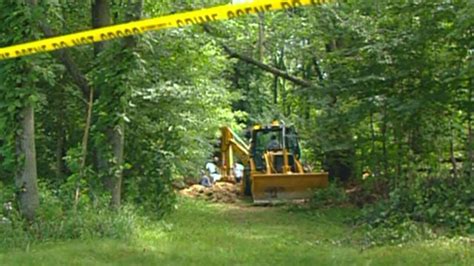
Human remains discovered in a creek near the former home of serial killer Herb Baumeister have intensified the investigation into potentially more victims, reigniting a decades-old mystery that has haunted Indiana. The discovery, made in early December, adds a chilling new chapter to the story of Baumeister, who preyed on gay men in the 1990s before taking his own life as authorities closed in.
The bones were found in a creek on the Fox Hollow Farm property in Westfield, Indiana, where Baumeister lived with his wife and children. This is the same property where the remains of at least eleven men were previously discovered in the mid-1990s. Hamilton County Coroner Jeff Jellison confirmed the discovery, stating, “We were contacted about bones found in a creek on the property… We responded and collected what appeared to be human bones.”
The recent search was prompted by new information and advanced forensic technology, allowing investigators to re-examine areas previously searched. According to Hamilton County Sheriff Dennis Quakenbush, “Based on some information we received, we decided to search another area of the property.” He added that the new technology has allowed investigators to explore areas that were previously inaccessible or difficult to examine thoroughly.
The Baumeister case dates back to the early 1990s when men began disappearing from gay bars in the Indianapolis area. Authorities initially struggled to connect the disappearances until a man named Tony Harris reported that Baumeister had taken him to his 18-acre estate and attempted to strangle him. Harris’s report provided the crucial break in the case.
Police obtained a search warrant for Fox Hollow Farm in 1996. While Baumeister initially cooperated, he soon fled to Canada as the investigation intensified. During the search of the property, investigators discovered the skeletal remains of several men buried in the woods. Facing mounting evidence and the prospect of arrest, Baumeister took his own life in Ontario, Canada.
Despite the discovery of remains on the property in the 1990s, investigators believed there could be more victims. The vastness of the property and the limitations of forensic technology at the time meant that some areas may have been overlooked. The recent discovery underscores those concerns.
The Hamilton County Coroner’s Office is working to identify the newly discovered remains, a process that could take weeks or even months. Forensic anthropologists are examining the bones to determine their age, sex, and potential cause of death. DNA analysis will be crucial in identifying the individuals and linking them to the Baumeister case.
“We’re going to do everything we can to identify these remains and bring closure to any families who may be affected,” Coroner Jellison stated. The identification process is particularly challenging due to the fragmented nature of the remains and the passage of time.
The Baumeister case has had a lasting impact on the LGBTQ+ community in Indianapolis. The disappearances of gay men in the 1990s created a climate of fear and distrust. Many felt that the police were slow to investigate the disappearances because the victims were gay. The case highlighted the vulnerability of the LGBTQ+ community and the importance of addressing hate crimes and discrimination.
Community leaders have emphasized the need to remember the victims and to continue working to ensure the safety and well-being of LGBTQ+ individuals. Advocacy groups have called for increased awareness and education about hate crimes and the importance of reporting suspicious activity.
The ongoing investigation into the Baumeister case serves as a reminder of the importance of perseverance and the pursuit of justice, even decades after the crimes were committed. The use of new technology and the dedication of investigators offer hope that more victims will be identified and that their families will finally find closure.
The discovery of the bones has also prompted renewed interest in the Baumeister case from true crime enthusiasts and the media. Several documentaries and podcasts have explored the case, examining the evidence, the victims, and the impact on the community. The renewed attention has also brought forth new leads and information, which investigators are actively pursuing.
The Baumeister case remains a complex and tragic chapter in Indiana’s history. The discovery of the new remains underscores the need for continued vigilance and the importance of bringing closure to the families of the victims. The investigation is ongoing, and authorities are committed to pursuing every lead to ensure that justice is served.
The investigation is not only focused on identifying the new remains but also on re-examining evidence from the original case. Investigators are using updated forensic techniques to analyze previously collected evidence, hoping to uncover new information about Baumeister’s crimes and the identities of his victims.
The recent discovery has also raised questions about whether Baumeister may have had accomplices. While he is believed to have acted alone, investigators are not ruling out the possibility that others may have been involved in his crimes. They are reviewing witness statements and other evidence to determine if there is any indication of accomplices.
The impact of the Baumeister case extends beyond the immediate victims and their families. The case has had a profound impact on the community, raising awareness about the vulnerability of marginalized groups and the importance of addressing hate crimes and discrimination. It has also served as a reminder of the importance of vigilance and the need to report suspicious activity to law enforcement.
The ongoing investigation into the Baumeister case is a testament to the dedication of law enforcement and the pursuit of justice. The use of new technology and the commitment to re-examining old evidence offer hope that more victims will be identified and that their families will finally find closure. The Baumeister case remains a complex and tragic chapter in Indiana’s history, but it is also a story of resilience, perseverance, and the unwavering pursuit of justice.
Frequently Asked Questions (FAQ)
1. Who was Herb Baumeister and what did he do?
Herb Baumeister was a businessman from Westfield, Indiana, who is believed to be a serial killer. In the 1990s, he preyed on gay men, luring them to his Fox Hollow Farm property and allegedly murdering them. Authorities discovered the remains of at least eleven men on his property in 1996. Baumeister fled to Canada as the investigation intensified and ultimately took his own life. He was never formally charged with the murders, but the evidence strongly suggests his culpability. Tony Harris had reported to police about Baumeister’s attempt to strangle him, but police took the report lightly at first and were not aware of the string of missing gay men.
2. What led to the recent discovery of bones on the Fox Hollow Farm property?
The recent discovery of bones in a creek on the Fox Hollow Farm property was prompted by new information and advanced forensic technology. According to Hamilton County Sheriff Dennis Quakenbush, “Based on some information we received, we decided to search another area of the property.” The new technology allows investigators to re-examine areas previously searched with greater precision and to explore areas that were previously inaccessible or difficult to examine thoroughly. This suggests that advancements in forensic science are now providing opportunities to uncover evidence that was missed during the initial investigation in the 1990s.
3. What is being done to identify the newly discovered remains?
The Hamilton County Coroner’s Office is working to identify the newly discovered remains. Forensic anthropologists are examining the bones to determine their age, sex, and potential cause of death. DNA analysis will be crucial in identifying the individuals and linking them to the Baumeister case. Coroner Jeff Jellison stated, “We’re going to do everything we can to identify these remains and bring closure to any families who may be affected.” The identification process is particularly challenging due to the fragmented nature of the remains and the passage of time, requiring meticulous analysis and comparison with existing missing persons databases.
4. How has the Baumeister case affected the LGBTQ+ community in Indianapolis?
The Baumeister case has had a lasting and profound impact on the LGBTQ+ community in Indianapolis. The disappearances of gay men in the 1990s created a climate of fear and distrust. Many felt that the police were slow to investigate the disappearances because the victims were gay, highlighting systemic issues and biases within law enforcement at the time. The case underscored the vulnerability of the LGBTQ+ community and the importance of addressing hate crimes and discrimination. Community leaders and advocacy groups have emphasized the need to remember the victims and to continue working to ensure the safety and well-being of LGBTQ+ individuals, advocating for increased awareness and education about hate crimes and the importance of reporting suspicious activity.
5. What is the current status of the investigation, and what are the next steps?
The investigation into the Baumeister case is ongoing, focusing on identifying the new remains and re-examining evidence from the original case. Investigators are using updated forensic techniques to analyze previously collected evidence, hoping to uncover new information about Baumeister’s crimes and the identities of his victims. They are also exploring the possibility that Baumeister may have had accomplices. The next steps involve meticulous forensic analysis, DNA comparison, and continued investigation into any new leads that may emerge. The authorities are committed to pursuing every lead to ensure that justice is served and closure is brought to the families of the victims.
Expanded Article:
The discovery of human remains in a creek near the former estate of serial killer Herb Baumeister has breathed new life into a decades-old cold case, offering a glimmer of hope for identifying potentially more victims and providing closure to grieving families. The chilling find, unearthed in early December, occurred on the infamous Fox Hollow Farm property in Westfield, Indiana, where Baumeister resided with his family and carried out his heinous crimes in the 1990s.
The remains, consisting of what appear to be human bones, were located in a creek that runs through the vast 18-acre property. Hamilton County Coroner Jeff Jellison confirmed the discovery, stating, “We were contacted about bones found in a creek on the property… We responded and collected what appeared to be human bones.” The discovery site is particularly significant, as it represents an area that, despite previous searches in the 1990s, may have been overlooked or inaccessible at the time due to limitations in technology and search techniques.
The renewed search, initiated based on fresh information and cutting-edge forensic technology, reflects a commitment to thoroughly investigate all possible leads and bring closure to the families of the victims. Hamilton County Sheriff Dennis Quakenbush explained, “Based on some information we received, we decided to search another area of the property.” The utilization of advanced technology signifies a significant advancement in the investigation, allowing investigators to explore previously unexamined areas with greater precision and detail.
The Baumeister case is a dark chapter in Indiana’s history, dating back to the early 1990s when a series of disappearances plagued the Indianapolis gay community. These disappearances initially baffled authorities, who struggled to connect the victims or identify a potential suspect. The breakthrough came when a man named Tony Harris bravely came forward, reporting a harrowing encounter with Baumeister. Harris recounted how Baumeister had lured him to Fox Hollow Farm and attempted to strangle him. This chilling account provided the vital link that law enforcement desperately needed to connect Baumeister to the missing men.
Armed with a search warrant, police descended upon Fox Hollow Farm in 1996. The initial investigation yielded minimal results, as Baumeister attempted to cooperate and deflect suspicion. However, as the investigation intensified and the evidence began to mount against him, Baumeister fled to Canada, leaving behind his family and a trail of unanswered questions. The subsequent search of the property revealed a horrifying discovery: the skeletal remains of at least eleven men buried in the wooded areas of the estate. Faced with overwhelming evidence and the prospect of imminent arrest, Baumeister tragically took his own life in Ontario, Canada, leaving behind a legacy of fear and unanswered questions.
Despite the significant discoveries made in the 1990s, investigators remained haunted by the possibility that there were more victims yet to be found. The vastness of the Fox Hollow Farm property, coupled with the limitations of forensic technology at the time, raised concerns that some areas may have been overlooked during the initial search. The recent discovery underscores these concerns, highlighting the potential for additional remains to be uncovered and identified.
The Hamilton County Coroner’s Office is currently engaged in the meticulous process of identifying the newly discovered remains. This process is complex and time-consuming, potentially taking weeks or even months to complete. Forensic anthropologists are carefully examining the bones to determine their age, sex, and any potential causes of death. DNA analysis will be crucial in definitively identifying the individuals and linking them to the Baumeister case, requiring painstaking comparison with existing DNA databases and familial DNA samples.
“We’re going to do everything we can to identify these remains and bring closure to any families who may be affected,” Coroner Jellison affirmed. The identification process is further complicated by the fragmented nature of the remains and the significant passage of time since the potential murders, requiring specialized forensic techniques and expertise to overcome these challenges.
The Baumeister case has left an indelible scar on the LGBTQ+ community in Indianapolis, creating a climate of fear and distrust that persists to this day. The disappearances of gay men in the 1990s were met with a sense of indifference and neglect by law enforcement, fueling the perception that the victims’ lives were somehow less valuable. This systemic failure to prioritize the investigation of these disappearances exacerbated the community’s sense of vulnerability and marginalization. The case serves as a stark reminder of the importance of addressing hate crimes and discrimination against LGBTQ+ individuals and ensuring that their safety and well-being are protected.
Community leaders and advocacy groups have emphasized the urgent need to remember the victims of the Baumeister case and to continue working towards creating a more inclusive and equitable society. They have called for increased awareness and education about hate crimes and the importance of reporting suspicious activity, as well as for greater support and resources for LGBTQ+ individuals who may be at risk.
The ongoing investigation into the Baumeister case serves as a powerful reminder of the enduring importance of perseverance and the relentless pursuit of justice, even decades after the crimes were committed. The utilization of new technology and the unwavering dedication of investigators offer a beacon of hope that more victims will be identified and that their families will finally find the closure they so desperately deserve.
The discovery of the bones has also ignited renewed interest in the Baumeister case from true crime enthusiasts and the media, bringing the story back into the public consciousness. Several documentaries and podcasts have delved into the details of the case, examining the evidence, the victims, and the profound impact on the community. This renewed attention has also generated new leads and information, which investigators are actively pursuing, underscoring the power of public awareness in assisting law enforcement efforts.
The Baumeister case remains a complex and tragic chapter in Indiana’s history, a testament to the dark side of human nature and the devastating consequences of unchecked evil. The discovery of the new remains underscores the need for continued vigilance and the unwavering commitment to bringing closure to the families of the victims. The investigation is ongoing, and authorities are dedicated to pursuing every lead to ensure that justice is served and that the memories of the victims are honored.
The investigation is not solely focused on identifying the newly discovered remains; it also involves a comprehensive re-examination of evidence from the original case. Investigators are employing updated forensic techniques to analyze previously collected evidence, seeking to uncover new information about Baumeister’s crimes and the identities of his victims. This meticulous re-analysis of old evidence could potentially reveal overlooked clues or connections that were not apparent during the initial investigation.
The recent discovery has also prompted renewed speculation about whether Baumeister may have had accomplices in his crimes. While he is widely believed to have acted alone, investigators are not ruling out the possibility that others may have been involved in his heinous acts. They are meticulously reviewing witness statements, forensic evidence, and other investigative materials to determine if there is any indication of accomplice involvement.
The impact of the Baumeister case extends far beyond the immediate victims and their families. The case has had a profound and lasting impact on the community, raising awareness about the vulnerability of marginalized groups and the critical importance of addressing hate crimes and discrimination. It has also served as a somber reminder of the importance of vigilance and the need to report suspicious activity to law enforcement, empowering citizens to play an active role in preventing future tragedies.
The ongoing investigation into the Baumeister case is a testament to the unwavering dedication of law enforcement and the enduring pursuit of justice. The utilization of cutting-edge technology and the commitment to re-examining old evidence offer a glimmer of hope that more victims will be identified and that their families will finally find the closure they have long sought. The Baumeister case remains a complex and tragic chapter in Indiana’s history, but it is also a story of resilience, perseverance, and the unwavering pursuit of justice, serving as a beacon of hope for those who have been affected by violence and loss. The case also serves as a cautionary tale about the importance of believing victims and taking all reports seriously, regardless of the victim’s background or lifestyle. It underscores the need for law enforcement to be responsive and proactive in addressing crimes against marginalized communities and to work collaboratively with community organizations to build trust and ensure safety. The legacy of the Baumeister case is a call to action to create a more just and equitable society where all individuals are valued and protected, and where the voices of victims are heard and believed. The renewed investigation and the potential identification of additional victims represent a significant step towards achieving justice and providing closure to the families who have waited for answers for far too long.









